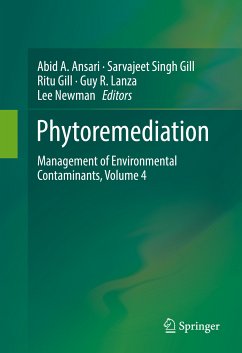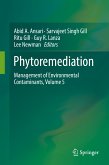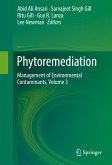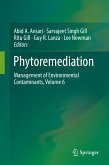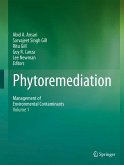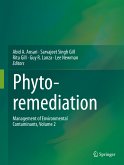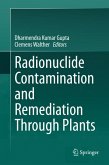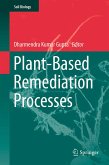Phytoremediation (eBook, PDF)
Management of Environmental Contaminants, Volume 4
Redaktion: Ansari, Abid A.; Newman, Lee; Lanza, Guy R.; Gill, Ritu; Gill, Sarvajeet Singh
113,95 €
113,95 €
inkl. MwSt.
Sofort per Download lieferbar

57 °P sammeln
113,95 €
Als Download kaufen

113,95 €
inkl. MwSt.
Sofort per Download lieferbar

57 °P sammeln
Jetzt verschenken
Alle Infos zum eBook verschenken
113,95 €
inkl. MwSt.
Sofort per Download lieferbar
Alle Infos zum eBook verschenken

57 °P sammeln
Phytoremediation (eBook, PDF)
Management of Environmental Contaminants, Volume 4
Redaktion: Ansari, Abid A.; Newman, Lee; Lanza, Guy R.; Gill, Ritu; Gill, Sarvajeet Singh
- Format: PDF
- Merkliste
- Auf die Merkliste
- Bewerten Bewerten
- Teilen
- Produkt teilen
- Produkterinnerung
- Produkterinnerung

Bitte loggen Sie sich zunächst in Ihr Kundenkonto ein oder registrieren Sie sich bei
bücher.de, um das eBook-Abo tolino select nutzen zu können.
Hier können Sie sich einloggen
Hier können Sie sich einloggen
Sie sind bereits eingeloggt. Klicken Sie auf 2. tolino select Abo, um fortzufahren.

Bitte loggen Sie sich zunächst in Ihr Kundenkonto ein oder registrieren Sie sich bei bücher.de, um das eBook-Abo tolino select nutzen zu können.
This text details the plant-assisted remediation method, "phytoremediation", which involves the interaction of plant roots and associated rhizospheric microorganisms for the remediation of soil contaminated with high levels of metals, pesticides, solvents, radionuclides, explosives, crude oil, organic compounds and various other contaminants. Each chapter highlights and compares the beneficial and economical alternatives of phytoremediation to currently practiced soil removal and burial practices.
- Geräte: PC
- ohne Kopierschutz
- eBook Hilfe
- Größe: 10.19MB
Andere Kunden interessierten sich auch für
![Phytoremediation (eBook, PDF) Phytoremediation (eBook, PDF)]() Phytoremediation (eBook, PDF)161,95 €
Phytoremediation (eBook, PDF)161,95 €![Phytoremediation (eBook, PDF) Phytoremediation (eBook, PDF)]() Phytoremediation (eBook, PDF)161,95 €
Phytoremediation (eBook, PDF)161,95 €![Phytoremediation (eBook, PDF) Phytoremediation (eBook, PDF)]() Phytoremediation (eBook, PDF)233,95 €
Phytoremediation (eBook, PDF)233,95 €![Phytoremediation (eBook, PDF) Phytoremediation (eBook, PDF)]() Phytoremediation (eBook, PDF)169,95 €
Phytoremediation (eBook, PDF)169,95 €![Phytoremediation (eBook, PDF) Phytoremediation (eBook, PDF)]() Phytoremediation (eBook, PDF)113,95 €
Phytoremediation (eBook, PDF)113,95 €![Radionuclide Contamination and Remediation Through Plants (eBook, PDF) Radionuclide Contamination and Remediation Through Plants (eBook, PDF)]() Radionuclide Contamination and Remediation Through Plants (eBook, PDF)113,95 €
Radionuclide Contamination and Remediation Through Plants (eBook, PDF)113,95 €![Plant-Based Remediation Processes (eBook, PDF) Plant-Based Remediation Processes (eBook, PDF)]() Plant-Based Remediation Processes (eBook, PDF)113,95 €
Plant-Based Remediation Processes (eBook, PDF)113,95 €- -29%11
-
-
This text details the plant-assisted remediation method, "phytoremediation", which involves the interaction of plant roots and associated rhizospheric microorganisms for the remediation of soil contaminated with high levels of metals, pesticides, solvents, radionuclides, explosives, crude oil, organic compounds and various other contaminants. Each chapter highlights and compares the beneficial and economical alternatives of phytoremediation to currently practiced soil removal and burial practices.
Dieser Download kann aus rechtlichen Gründen nur mit Rechnungsadresse in A, B, BG, CY, CZ, D, DK, EW, E, FIN, F, GR, HR, H, IRL, I, LT, L, LR, M, NL, PL, P, R, S, SLO, SK ausgeliefert werden.
Produktdetails
- Produktdetails
- Verlag: Springer International Publishing
- Seitenzahl: 409
- Erscheinungstermin: 23. September 2016
- Englisch
- ISBN-13: 9783319418117
- Artikelnr.: 46923153
- Verlag: Springer International Publishing
- Seitenzahl: 409
- Erscheinungstermin: 23. September 2016
- Englisch
- ISBN-13: 9783319418117
- Artikelnr.: 46923153
- Herstellerkennzeichnung Die Herstellerinformationen sind derzeit nicht verfügbar.
Dr. Abid A Ansari, M.Sc., Ph.DDepartment of Biology, University of Tabuk Tabuk, Kingdom of Saudi Arabia Dr. Sarvajeet Singh Gill, M.Sc. (Gold medal), M.Phil., Ph.D Dr. Ritu Gill, Ph.D Stress Physiology and Molecular Biology Lab, Centre for Biotechnology, MD University, Rohtak 124 001, Haryana, India Dr. Guy R. Lanza, Ph.D. College of Environmental Science and Forestry State University of New York (SUNY) Syracuse, NY 13210-2778 USA Dr. Lee Newman, Ph.D College of Environmental Science and Forestry State University of New York (SUNY) Syracuse, NY 13210-2778 USA
Section 1. Phytoremediation of Organic Contaminants.- Phytoremediation of PCBs and PAHs by Grasses: A Critical Perspective.- Organic Soil Amendments in the Phytoremediation Process.- Phytoremediation of Crude Oil Contaminated Soil using Cynodon dactylon (L.) Pers).- A Study on Degradation of Heavy Metals in Crude Oil Contaminated Soil using Cyperus rotundus.- Polycyclic Aromatic Hydrocarbons and Heavy Metal Contaminated Sites: Phytoremediation as a Strategy for Addressing the Complexity of Pollution.- Phytoremediation of Polycyclic Aromatic Hydrocarbons (PAHs) in Urban Atmospheric Deposition Using Bio-retention Systems.- Section 2. Wastewater Engineering and Technology.- Plant Growth Promoting Bacteria: A Good Source for Phytoremediation of Metals Contaminated Soil.- Biotechnological Approaches to Remediate Soil and Water using Plant-Microbe Interactions.- Current and Future Opportunities for Forest Land Application Systems of Wastewater.- Bio-retention Systems for Storm water Treatment and Management in Urban Systems.- Fungal Laccase Enzyme Applications in Bioremediation of Polluted Wastewater.- Section 3. Natural and Constructed Wetlands for Phytoremediation.- Phytoremediation Applications for Waste Water and Improved Water Quality.- Plants for Constructed Wetlands as an Ecological Engineering Alternative to Road Runoff Desalination.- Constructed Wetlands for Livestock Wastewater Treatment: Antibiotics Removal and Effects on CWs Performance.- Phytoremediation Potential of Selected Mangrove Plants for Trace Metal Contamination in Indian Sundarban Wetland.- Fate of Phenolic Compounds in Constructed Wetlands Treating Contaminated Water.- Removal of Pathogenic Bacteria in Constructed Wetlands: Mechanisms and Efficiency.- Section 4. Phytoremediation for Reclamation and Restoration.- Low-Tech Alternatives for the Rehabilitation of Aquatic and Riparian Environments.- Proposed Rehabilitation Method of Uncontrolled Landfills in Insular CommunitiesThrough Multi CriteriaAnalysis Decision Tool.- Suitability of Different Mediterranean Plants for Phytoremediation of Mine Soils Affected with Cadmium.
Section 1. Phytoremediation of Organic Contaminants.- Phytoremediation of PCBs and PAHs by Grasses: A Critical Perspective.- Organic Soil Amendments in the Phytoremediation Process.- Phytoremediation of Crude Oil Contaminated Soil using Cynodon dactylon (L.) Pers).- A Study on Degradation of Heavy Metals in Crude Oil Contaminated Soil using Cyperus rotundus.- Polycyclic Aromatic Hydrocarbons and Heavy Metal Contaminated Sites: Phytoremediation as a Strategy for Addressing the Complexity of Pollution.- Phytoremediation of Polycyclic Aromatic Hydrocarbons (PAHs) in Urban Atmospheric Deposition Using Bio-retention Systems.- Section 2. Wastewater Engineering and Technology.- Plant Growth Promoting Bacteria: A Good Source for Phytoremediation of Metals Contaminated Soil.- Biotechnological Approaches to Remediate Soil and Water using Plant-Microbe Interactions.- Current and Future Opportunities for Forest Land Application Systems of Wastewater.- Bio-retention Systems for Storm water Treatment and Management in Urban Systems.- Fungal Laccase Enzyme Applications in Bioremediation of Polluted Wastewater.- Section 3. Natural and Constructed Wetlands for Phytoremediation.- Phytoremediation Applications for Waste Water and Improved Water Quality.- Plants for Constructed Wetlands as an Ecological Engineering Alternative to Road Runoff Desalination.- Constructed Wetlands for Livestock Wastewater Treatment: Antibiotics Removal and Effects on CWs Performance.- Phytoremediation Potential of Selected Mangrove Plants for Trace Metal Contamination in Indian Sundarban Wetland.- Fate of Phenolic Compounds in Constructed Wetlands Treating Contaminated Water.- Removal of Pathogenic Bacteria in Constructed Wetlands: Mechanisms and Efficiency.- Section 4. Phytoremediation for Reclamation and Restoration.- Low-Tech Alternatives for the Rehabilitation of Aquatic and Riparian Environments.- Proposed Rehabilitation Method of Uncontrolled Landfills in Insular CommunitiesThrough Multi CriteriaAnalysis Decision Tool.- Suitability of Different Mediterranean Plants for Phytoremediation of Mine Soils Affected with Cadmium.
